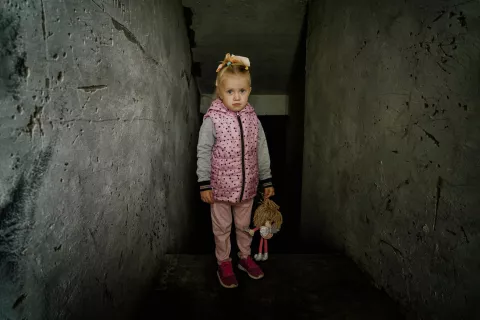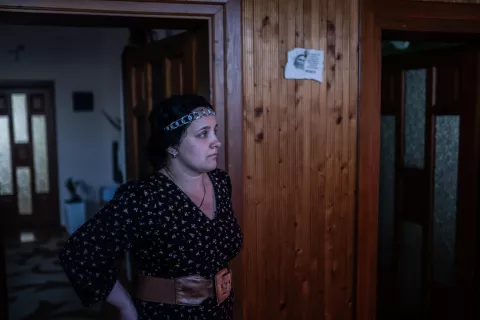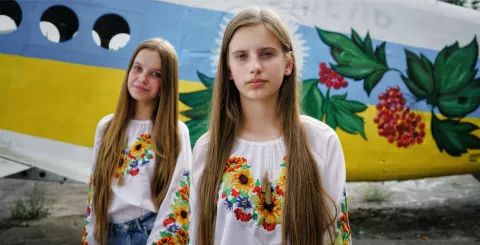Ukraine war response: Children with disabilities
As in other emergencies, children with disabilities are among the most impacted by conflict.

The war in Ukraine has had a devastating effect on families and impacted every child’s wellbeing. Children have been uprooted from their homes, separated from caregivers and directly exposed to war. They have been shaken by bomb explosions and the blaring sirens of missile alert systems. But, as in other emergencies, children with disabilities have been particularly vulnerable and affected by the violence, displacement, and prolonged exposure to stress.
Before the war, Ukraine had the highest number of children in institutional care in Europe – more than 90,000 children living in residential care institutions, including orphanages boarding schools and other care facilities. Nearly half of them were children with disabilities.
Since the war began, tens of thousands of children from boarding schools have been returned to families, many of them hastily and without the care and protection they require. Thousands more have remained in institutions, or have been relocated inside Ukraine or evacuated to neighboring countries. Moving children with disabilities safely has proved difficult, and in some cases impossible, with some children with disabilities behind as caregivers and staff of the institutions attended to their family needs and safety. International advocacy groups have documented these cases, demonstrating again how institutional care, especially for children with disability fails to deliver on children’s fundamental rights.
But this is, unfortunately, not a new phenomenon. In humanitarian contexts, children with disabilities often remain invisible in terms of needs assessment and the response, both in terms of their care and protection, but also in terms of their access to education, health, social services and other support. In part this is because of stigma or safety concerns, which can result in marginalization and exclusion of families with disabilities from the humanitarian response and attention. When the war started in Ukraine, many children with disabilities weren’t included in evacuation plans, and have faced a lack of access to shelters, essential services, medicine, and food.
Meanwhile, as in other emergencies, it is crucial that children with disabilities are prioritized in social protection, healthcare or education planning and provision, and that their specific needs for accessibility and additional support are addressed.
Among the key challenges UNICEF has identified are:
Protection
-
Children with disabilities, particularly girls, are much more likely to experience violence, abuse, and neglect than children without disabilities. These risks have been amplified during the current war with many children with disabilities separated from their usual support networks.
-
Children with disabilities are at higher risk of being among civilian casualties as they face greater difficulties finding safety due to lack of accessible transport and shelters. They may also face barriers to accessing life-saving information, including about evacuation and humanitarian assistance, as well as warning signals such as air raid sirens.
-
Children with disabilities currently in institutions experience adverse effects including poor living conditions, overcrowded facilities, inadequate care due to lack of staff as well as a lack of essential medicine, food and hygiene supplies. Children with severe disabilities with high support needs are particularly vulnerable and don’t receive the individual attention and support they require.
Internally displaced persons
-
Around two-thirds of Ukrainian children have been displaced since the start of the war as people continue to flee their homes. Around 1-in-5 internally displaced persons in Ukraine have a developmental delay or disability.
-
Internally displaced adults and children with disabilities have been separated from support networks and services. Newly-formed sites and camps, meanwhile, have limited accessible and inclusive services.
-
Children from residential care institutions in eastern Ukraine have in many cases been relocated to other institutions in the west of the country without any documentation and tracking.
Evacuation
-
Families who have members with disabilities often have difficulty evacuating on their own due to barriers to accessing information about evacuation, limited accessibility of roads and limited transportation, and a lack of assistive devices.
-
In addition, transporting children with disabilities with high support needs may pose a particular risk to their health and well-being, and have additional costs.
Refugees
-
Families with children with disabilities are at higher risk of being separated as a result of relocation or evacuations.
-
National systems in refugee-hosting countries are overstretched, impacting the availability and quality of specialized services for refugees with disabilities, as well as limiting their opportunities to access school and other activities.
UNICEF’s response

The Government and partners are aware of these important gaps, and are working to address the urgent needs of children and their families with disabilities. UNICEF is working with partners to scale up its humanitarian efforts to respond to the growing needs of refugees and internally displaced persons across the country and in neighboring countries, including those of adults and children with disabilities. UNICEF also prioritizes advocacy aimed at enhancing security and preventing violations against children, including those with disabilities.
In Ukraine, UNICEF is:
- Supporting the Government in creating an environment in which children with disabilities can receive appropriate care and protection and support for family reunification.
- Child protection mobile teams are providing psychosocial care to children and caregivers in government-controlled areas in Ukraine and case management support for the most vulnerable families with children. This includes cases of gender-based violence, unaccompanied or separated children, and other extremely vulnerable internally displaced families with children.
- In cooperation with the Government, UNICEF is supporting a national effort to ensure every child currently in an institution or who was returned to family receives case management support, including life saving interventions, and support to access basic and more specialized services. Dedicated teams of disability and child protection specialists are recruited to assess the needs of children with disabilities, who made up nearly 50 per cent of children in institutions across Ukraine pre-war, to ensure they are properly referred for the support they need.
- Supporting local partners specializing in service provision for children with disabilities to provide rehabilitation services, assistive technology and inclusive supplies, critical hygiene supplies, and non-food items to children with disabilities and their caregivers.
In neighbouring countries, UNICEF support includes:
- Working with UNHCR and partners to activate Blue Dot hubs – one-stop safe spaces for children and women. Blue Dots provide key information to traveling families, help to identify unaccompanied and separated children and ensure their protection.
- Ensuring identification and registration of children with disabilities and supporting access to community-based services, including early interventions, appropriate therapy and rehabilitation.
- Supporting governments in absorbing additional children into schools, including support for children with disabilities.
- Expanding preschool provision for refugee children, including those with disabilities, as well as supporting parental well-being, and building capacity among early childhood development workforces.
- Installing mobile sanitation facilities at border crossing areas, including those catering to people with disabilities.
- Supporting alternative care arrangements and family-based care options that are disability sensitive where appropriate.
- Working with municipalities caring for refugee children with disabilities by supporting access and complementing services in health, nutrition, water sanitation and hygiene (WASH), and multi-purpose cash transfers so that basic needs are met, all while abiding by principles of non-discrimination in access to protection and services.
- Longer term, mapping the capacities of national services and prioritizing action to address gaps in service provision.




